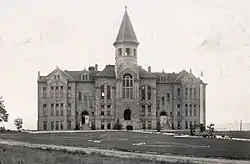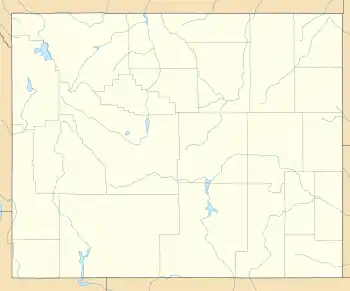Old Main (University of Wyoming)
Old Main, built in 1886, was the first and is the oldest remaining building on the University of Wyoming campus, in Laramie, Wyoming. The building currently houses University administration.
Old Main | |
 Old Main in 1908 | |
  | |
| Location | University of Wyoming campus, Ninth St. and Ivinson Ave., Laramie, Wyoming |
|---|---|
| Coordinates | 41°18′43″N 105°35′2″W |
| Built | 1896 |
| Built by | Cook & Callahan |
| Architect | Frederick Albert Hale |
| Architectural style | Romanesque Revival |
| NRHP reference No. | 86001536 [1] |
| Added to NRHP | July 11, 1986 |
History
Old Main was built as a result of the University Bill, passed by the government of the Territory of Wyoming. In a compromise among territorial legislators, Laramie was given the University, Cheyenne was given the capitol, and Evanston was given $10,000 to build an insane asylum.[2] All three cities were at the time fast-growing centers in their area connected by the railroad.
Territorial Governor Francis E. Warren appointed three Laramie residents to a building commission (J.W. Donnellan, LeRoy Grant and Robert Marsh) and allocated $50,000 to build the first University Building in the Wyoming Territory.[3] The building commission contracted Frederick Hale to design and Cook and Callahan to construct the building.[4]
Architecture and construction
Frederick Hale began his career as an architect in Denver around 1890. After designing Old Main early in his career, Hale moved to Utah where he proceeded to become an important figure in Salt Lake City architecture. Hale's portfolio included are the David Keith Mansion, the Downey House, the Haxton Place, and the Markland/Walker House, all built on Salt Lake City's historic Temple Street. He also built the A.O. Whitmore Electric Automobile Building in Salt Lake City.[5]
Old Main was built in the Romanesque Revival style. The heavy stone construction, the axial nature, the use of symmetry, the use of the arch, and the rectangular footprint displayed at Old Main are all strong characteristics of Romanesque construction. The primary stone used is rough-cut sandstone quarried from east of Laramie. The trim stone is Potsdam Sandstone quarried from the Rawlins area. This stone is smooth in texture providing contrast to the native sandstone.
Being the first University building in the Wyoming Territory, Old Main needed to be a monumental structure, so Hale designed symmetrical building with a central spire. The spire served as both a focal point for the structure and a signal of importance to anyone passing by.
Rather than designing a building similar to university structures of the East, Hale designed Old Main in the context of Wyoming. The rough-textured body of the building represented the developing frontier, while the minimal usage of classical decoration symbolized the emerging sophistication of the Wyoming population.
The cornerstone was laid on September 27, 1886 by the Masonic Order. Construction was completed on September 1, 1887; just in time for classes to begin on September 6, 1887. When opened, Old Main was called the University Building because it housed the entire university: classrooms, labs, administration, maintenance, an auditorium and a library were included, plus a two-story, 500-seat auditorium on the second level that quickly became the entertainment center for Laramie.
Later changes
The central spire was removed in 1916 due to structural concerns, completely changing the character of the structure, and resulting in a somewhat awkward central section (now hidden by two large spruce trees). After the campus expanded the building was renamed the Language Building.
The auditorium was reduced in size during a 1936 renovation and then completely removed in 1949. This remodeling drastically changed the building's interior and did not match the original style. The auditorium was replaced by a large central staircase and two stories of office space still in use today. The 1949 remodeling also officially changed the buildings name to Old Main. The office of the president was remodeled at this time and remains much unchanged today.
Originally the entrances to Old Main were elevated above ground level so that visitors would ascend to the first floor before entering the building; they were modified in 1949 so that visitors now enter down to the basement level.
Context
Two Wyoming structures which could most be considered contemporary to Old Main are the Union Pacific Train Depot (1886) in Cheyenne, and the State Capitol building (construction began in 1887) also in Cheyenne. At the time of construction, Old Main would have had a similar level of importance to the Wyoming Territory as the other two structures. Because of their importance to the history of Wyoming and their architectural significance, these two buildings are now listed with the National Register of Historic Places.
Together these three structures show that the 1880s were a time of excitement, growth, and change. Shortly after the construction of Old Main, the state of Wyoming was accepted to the union in 1890.
Influence
Old Main had a strong influence on the direction of architecture on the University of Wyoming campus. It heavily influenced later campus construction, visible from the similar use of native stone on virtually every building and the similar three portal design used on buildings such as Half Acre Gymnasium. University structures built today use modern construction techniques and materials such as steel but still incorporate a rough-cut sandstone façade, resulting in a uniform architecture throughout the campus.
References
- "National Register Information System". National Register of Historic Places. National Park Service. April 15, 2008.
- Mason, Mary Kay (1987). History of Laramie, Wyoming: Volume 1 Laramie – Gem City of the Plains.
- Hardy, Deborah (1986). Wyoming University: The First 100 Years 1886-1986.
- "Old Main History". University of Wyoming.
- "Utah Heritage Foundation".
External links
| Wikimedia Commons has media related to Old Main (University of Wyoming). |
- Old Main at the Wyoming State Historic Preservation Office